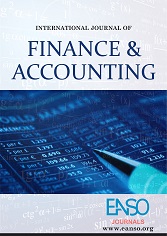Capital Structure and Financial Performance of Manufacturing Companies Listed at the Nairobi Securities Exchange in Kenya
Abstract
The mix of debt and equity that a business uses to finance its operations is referred to as its capital structure. Thus, it is the configuration of an organization's primary financial sources. Funding for this study came from equity, loan financing, and lease financing. One of the key choices that managers of a company must make in order to accomplish the company's objectives is capital structure. Finding out how capital structure impacted the financial performance of manufacturing companies listed on the Nairobi Securities and Exchange was the main goal of the study. The study's specific goals were to ascertain how the financial performance of manufacturing companies was impacted by loan finance, which was the primary source of outside funding, equity finance, which included the amount of retained profits reinvested in the company, and lease finance, which is defined as the agreement made between a specific asset owner (lessor) and the lessee. Four theories—trade-off theory, pecking order theory, information signalling theory, and agency theory—formed the basis of the study's theoretical model. In order to finish the study, a descriptive research design was used in conjunction with a quantitative research approach. Nine manufacturing firms that are openly traded on the NSE were surveyed. The NSE and the financial statements made public by Kenyan manufacturing companies listed on the NSE provided secondary data for the study. Secondary data was collected annually between 2013 and 2022. The study's instrument for gathering data was a data collection sheet, and a panel regression model was used. Descriptive and inferential analysis were also used to draw conclusions from the information gathered. An indirect association was discovered when the impact of loan financing was investigated. While the relationship between equity finance and return on equity revealed a clear association, a lower level of loan finance was linked to an increase in the return on equity of the enterprises under consideration. Additionally, the statistical study showed that the dependent variable, return on equity, and the chosen capital structure factors had a strong association. According to this study, the model has a strong explanatory power, accounting for almost 93% of the variance in return on equity.
Downloads
References
Ajibola, A., Wisdom, O., & Qudus, O. L. (2018). Capital structure and financial performance of listed manufacturing firms in Nigeria. Journal of Research in International Business and Management.
Abdul, G. K. (2012). The Relationship of Capital Structure Decisions with Firm Performance: A Study of the Engineering Sector of Pakistan. International Journal of Accounting and Financial Reporting, 2(1), 2162-3082.
Baxter, Nevis D. (1967). Leverage, Risk of Ruin and the Cost of Capital. The Journal of Finance 22, no. 3: 395 – 403.
Doan T., (2020) Management Science Letters 10 (4), 849-854 Capital Structure and Firm Performance; Evidence from Emerging Country.
Gill, A., Nahum B., & Neil, M. (2011). The effect of capital structure on profitability: Evidence from the United States. International Journal of Management, 28(4) (1), 3-15.
Grigore, M. Z., & Stefan-Duicu, V. M. (2013). Agency theory and optimal capital structure. CKS Journal, Bucharest, 862-868.
Ishaya, L. C., & Abduljeleel, B. O. (2014). Capital Structure and Profitability of Nigerian Quoted: The Agency Cost Theory Perspective. American International Journal of Social Science, 3(1), 139-140.
Javed, B. & Akhtar, S. (20 12). Interrelationships between Capital Structure and Financial Performance, Firm Size and Growth: Comparison of industrial sector in KSE: European Journal of Business and Management, 4(15), 148-157.
Jensen, M. C., & Meckling, W. H. (1976). Theory of the firm: Managerial behavior, agency costs and ownership structure, Journal of financial economics, 3 (4), pp. 305-360.
Kerongo M. M., (2022). Capital Structure, Firm Size Liquidity and Financial Performance of Non-Financial Firms Listed at the NSE.
Kraus, A., & Litzenberger, R.H. (1973). A state-preference model of optimal financial leverage. The Journal of Finance, vol. 28.
Kurfi, A. K. (2009). Corporate Capital Structure and Lease Financing Practices of Selected Manufacturing Firms in Nigeria. European Journal of Economics, Finance and Administrative Sciences, 12(17), 27-33.
Masavi, J. et.al (2017). Capital Structure and Financial Performance in Kenya: Evidence from Agricultural Companies Listed at the Nairobi Securities Exchange. International Journal of Economics, Commerce and Management.
Modigliani, F., & Miller, M. (1958). The Cost of Capital, Corporation Finance, and the Theory of Investment. The American 1: 3
Murray Z. F., & Vidhan K. G. (2005). Trade-off and Pecking order Theories of Loan.Working paper, Tuck School of Business Dartmouth.
Mutua L. M., & Atheru, G. K. (2020). Capital Structure and Financial Performance of Listed Manufacturing Firms at Nairobi Securities Exchange in Kenya. Journal of Finance and Accounting 4 (1), 24-38.
Myers, S. C., & Majluf, N. S. (1984). Corporate financing and investment decisions when firms have information that investors do not have. Journal of Financial Economics.
Ross, S.A. (1977). The Determination of Financial Structure: The Incentive Signaling Approach. Bell Journal of Economics, 8, 23-40.
Shubita, M. F., & Alsawalhah, J. F. (2012). The Effect of Capital Structure and Profitability.International Journal of Business and Social Science, 3(16).
Singh, M., & Faircloth, S. (2005). The Impact of Corporate Loan on Long Term Investment and Firm Performance; Applied Economics, 37, 875–883.
Copyright (c) 2025 Neema Ndung'u, Kalundu Kimanzi, PhD

This work is licensed under a Creative Commons Attribution 4.0 International License.




























